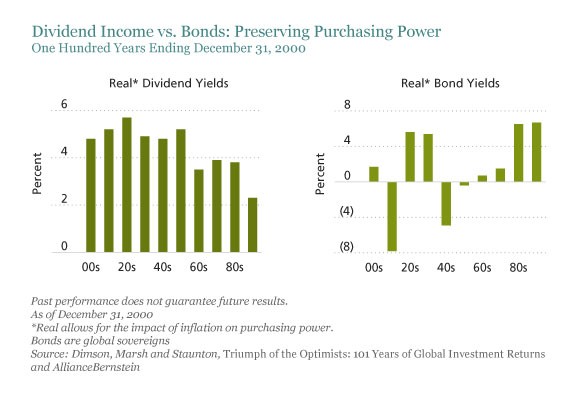5 Reasons Why Dividend Stocks May Be Better Than Bonds
Post on: 2 Апрель, 2015 No Comment

Are you interested in increasing the fixed income portion of your investment portfolio, but completely unhappy at the fact that even very long-term bonds are paying interest rates in the low single digits? If you are, there are at least five reasons why dividend stocks may be better than bonds, if income is what you are looking for.
1. When interest rates rise, bond prices fall
Bond funds are not risk free
While there is a general perception of safety when it comes to investing in bonds, that mostly applies to the shortest term securities (under five years). Bonds, long-term bonds in particular (maturities of 10 years or more), are interest rate sensitive, and move in inverse directions to interest rate changes.
If you are holding a 20 year bond with a 3% coupon rate, and interest rates rise to 4%, the value of your bonds will fall significantly. This happens because bond prices adjust to roughly match the yield on currently issued securities.
Dividend stocks are likely to be affected by rising interest rates as well. However, the effect will generally be less for dividend stocks than for bonds. This is because dividend stocks are first and foremost stocks – not bonds – and also because the issuing company always has the option to increase the dividend payment in order to support the stock price.
To think of the relationship in the simplest terms, in a rising rate environment, dividend stock prices may fall, but bond prices will fall.
2. Long-term bonds behave more like stocks than fixed income investments
Bonds with maturities of greater than 10 years, and especially more than 20 years, can behave a lot more like stocks than like bonds. The reason is because of changes in interest rates, as discussed above.
This may not be a problem if you fully understand this potential, and fully expect interest rates to fall in the near future (causing bond prices to rise). That can be a perfect marriage of price appreciation and a steady flow of interest income.
The problem however is that many investors don’t completely appreciate or even expect this potential. They believe that they are simply locking in a long-term stream of interest income on a particular bond issue. But once they buy in, and watch the price of the bond swing wildly in both directions, they may begin to realize that the securities they are holding are anything but safe .
It’s okay to buy bonds that behave like stocks if that’s what you fully expect. But for the most part, if you are going to invest in anything that behaves like stocks, you’re far better off investing in stocks themselves.
3. Yield and investment quality move in opposite directions with bonds
Still another complication with bonds is the fact that yield and investment quality move in opposite directions. In the search for higher yields, you might naturally gravitate toward those bonds that pay the highest rate of return. But the problem with this strategy is that bonds that pay the highest returns are also those of the poorest quality.
At the extreme, you may be investing in junk bonds (though no one likes to call them that anymore), that have a very high potential for default.
No matter how much you are earning in interest on a given bond, you can lose everything you have in the event the issuer defaults.
This is not true with dividend stocks. In fact, it can be quite the opposite – the highest quality companies could very well be paying the highest dividend yields. This can happen simply because the highest quality companies are in the best position to do so. They are the most profitable companies, and generally have a long track record of returning a substantial portion of those profits to their shareholders.
4. Dividend stocks offer potential price appreciation
Though bonds can offer potential price appreciation in a declining interest rate market, that is not their primary function. However, dividend stocks have always had the advantage of offering both high-yield and potential price appreciation. They are, after all, stocks – and price appreciation is the major reason people buy stocks at all.
With bonds, price appreciation is something of an unexpected gift. When it comes to dividend stocks, price appreciation is a part of the regular and expected package.
5. Dividends can be increased on dividend stocks bond rates don’t increase
When you buy a bond, you’re actually buying a piece of a legal contract. That contract spells out all of the terms of the bond. The bond is actually a debt instrument, that carries a specific issuance date, face amount, interest rate, and date of redemption. The interest rate on the bond will never change.
That may be a comfort in a declining interest rate environment because you will continue to get the same rate of return even if rates drop. But should rates increase in the general market, the interest rate on your bonds will not be adjusted upward to reflect this change.
Dividend stocks always carry the potential to increase their dividend payout. In fact, successful companies tend to increase their dividend payouts over the long run as a matter of course. The stock you purchase today with a 3% dividend yield, could produce a 6% return on your original investment in five years, simply as a result of the company increasing its dividend steadily.
Have you considered using dividend stocks to make up at least a portion of your fixed rate portfolio allocation?














